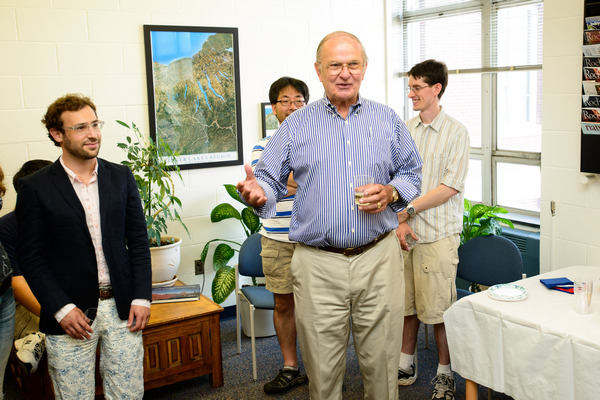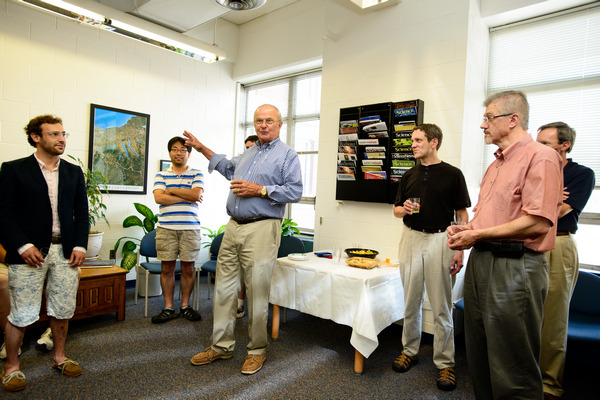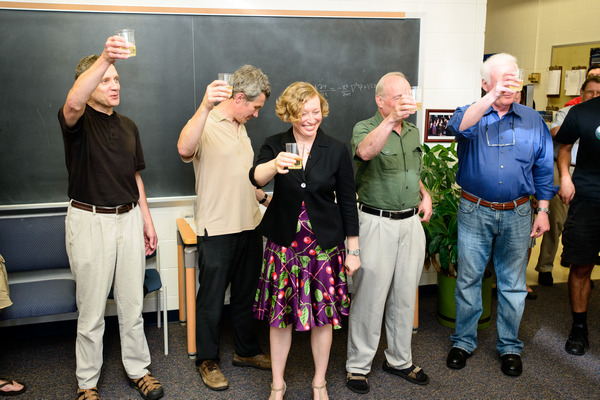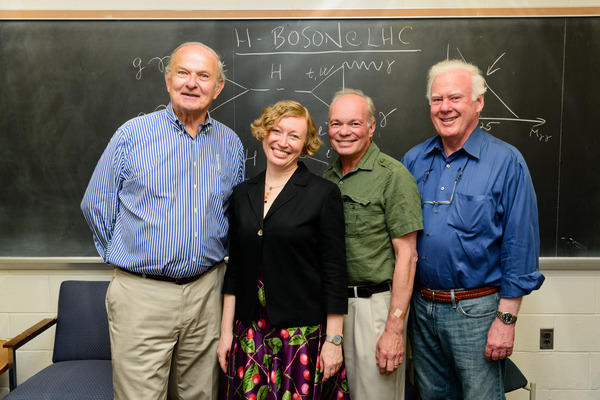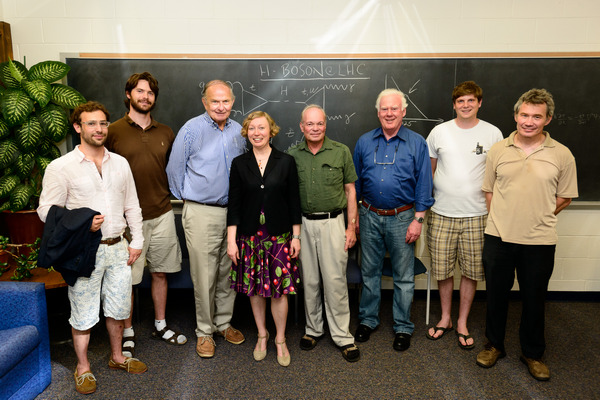University of Rochester
Hagen Calls CERN Findings a ‘Remarkable Achievement’ but Says More Work Is Needed
July 4, 2012
Physicist Carl Hagen, one of the original scientists to develop the theories on the Higgs mechanism and Higgs boson, applauded the apparent success of CERN scientists in finding evidence of the elusive subatomic particle. Hagen was in attendance at CERN’s research facilities near Geneva, Switzerland, on July 4, when researchers announced the discovery of a new particle that is “consistent with the Higgs boson.”
The announcement was based on the findings of two separate experiments—CMS and Atlas—being conducted at CERN’s Large Hadron Collider (LHC).
“The work is very impressive and is a truly remarkable achievement,” said Hagen. “Yet that is not to say that it is the long-sought boson. Its spin has yet to be determined, for example.”
The Higgs boson, which makes it possible for particles to have mass, is the only particle predicted by the Standard Model of particle physics that has not yet been observed.
His 1964 article, “Global Conservation Laws and Massless Particles,” cowritten by Gerald Guralnik and Thomas Kibble, was named one of the milestone papers in the history of Physical Review Letters.
Hagen traveled to Switzerland for the historic announcement. He described the presentation at CERN as unusual and extraordinary, with the talks “interspersed with bouts of prolonged applause.”
The Higgs boson is believed to be responsible for other particles having mass. It is the only particle predicted by the Standard Model of particle physics that has not yet been observed.
Read more about the July 4 announcement in Science News (July 4, 2012)
Question and Answer with Particle Physicist Carl Richard Hagen (August 2010)
Interview by Alan Blank, University Communications

Carl Hagen, Professor of Physics & Astronomy
Rochester physicist Carl Hagen and other scientists look forward to finally “pinning things down” in the Standard Model.
In March 2010, scientists and laypeople alike watched as the Large Hadron Collider, on the French-Swiss border, was fired up and beams of protons were collided at the highest energies ever observed. Work by Carl Hagen, a professor of physics and astronomy, carried out more than 40 years ago, paved the way for some of the theories that are to be explored and tested with the new facility.
The Standard Model of physics does not account for particle mass, but a theory developed by Hagen, along with several other renowned scientists—including Peter Higgs, namesake of the famed Higgs particle—does. They won the 2010 J.J. Sakurai Prize for Theoretical Particle Physics from the American Physical Society for their amendment of the Standard Model, which explains how particles interact.
Q: Why is the Standard Model valuable?
A: Remarkably, it seems to fit everything. New things come along and the theory accommodates all of the new phenomena that we explore. It has just been incredibly resilient, and that wasn’t the case with previous theories, which had a very limited focus.
Q: Elementary particle physics is a relatively new field when compared with the physics that most people are familiar with like Newtonian mechanics or even Einstein’s theory of relativity. What kinds of fundamental questions are left unanswered that work in these large accelerators seeks to answer?
A: We want to know what are the fewest possible equations that you can write down that are going to explain everything. Particle physics holds out the possibility that you can write down such equations and that they have solutions that correspond to all of the exotic particles that have been discovered in recent decades. Also, as we explore cosmological applications, it provides the tools that enable us to look far back in time and to understand what happened in the early universe.
Q: The Large Hadron Collider will allow us for the first time to collide particles at high enough energies to investigate and perhaps prove the existence of the Higgs particle that you and your colleagues theorized. What does the Higgs particle do?
A: There’s nothing in the basic equations of the Standard Model that defines the scale of a mass. They do not have a mass parameter, something that would allow you to say this particle weighs so many pounds or so many kilograms. It’s only when you break this symmetry, which leads you to expect that a given parameter is zero, that you get a value for that parameter that is not zero, and that thing that is not zero is mass. This symmetry is broken through the Higgs mechanism that propagates out into this entire set of particles and fields, and it’s the only thing that allows you to associate a mass with these particles.
By the way, some of our colleagues are trying to rename the Higgs particle the BEHHGK particle, to put the six initials [of the members of the three groups of individuals who first theorized its existence] in there.
Q: So the Higgs particle allows for a mass where the Standard Model before the Higgs particle did not allow for mass.
A: Right. Because you have these theories which have these wonderful properties that you can actually do credible calculations with them and it’s because they have no mass in them. If you take these particles and impose a mass on them, everything goes to hell in a hand basket; things get out of control and you can’t do any realistic calculations. So the Standard Model had to have the Higgs particle or something akin to it. You break the symmetry, you have a mass parameter, and that is the thing that just percolates through the entire system and gives mass to everything at some level.
Q: If the Large Hadron Collider is able to detect the Higgs particle, what will that mean for the field of particle physics?
A: I guess that will be the final nail that pins this thing down. There are more complicated ways to break the symmetry to which we’ve been referring. The three groups that did this research all basically used the same model because it’s the simplest one that can work.
Q: And if it isn’t found?
A: It could happen that the mechanism is a lot more complicated than we predicted. It would still be in the spirit of this, but it wouldn’t be the same simple approach that we all wanted, so we’re sure hoping the Higgs particle will be there to justify our minimal approach.
Q: After the discovery of the Higgs particle would the Standard Model be a theory that can describe any physical interaction that we know of? Would it be a unified theory of everything?
A: With the exception of gravity, yes. If we exclude that particular complication, it could be the theory of everything. Steve Weinberg, who is one of the leaders of theoretical particle physics [and a Nobel laureate], says that one of the worst things that could happen is that the Large Hadron Collider finds this Higgs particle and nothing else. That would mean that life is going to be boring for a long time, maybe forever. His hope is that yes we will find the so-called Higgs, and we are going to find such a wealth of other things in this highly energetic domain that is just opening to us that it is going to give life to particle physics for generations to come.
In another domain, when the Berlin Wall came down a lot of people said, well that’s the end of history, everything else is boring now, right? Well, it hasn’t been exactly boring since then. But it might be boring in physics if no extra things are found.
Read more about Professor Hagen:
- "UR professor Carl Hagen heading to Switzerland for 'God particle' announcement" Democrat and Chronicle, Jul 2, 2012
- "World’s Biggest Science Experiment" Rochester Review
- Department of Physics and Astronomy faculty page
- Nobelist Steven Weinberg Praises Professor Carl Hagen and Collaborators for Higgs Boson Theory
- Carl R. Hagen Wins 2010 J. J. Sakurai Prize for Theoretical Particle Physics
- Wikipedia - C.R. Hagen
- Physical Review Letters: Global Conservation Laws and Massless Particles
- "UR prof makes sense of Big Bang" Democrat and Chronicle, Oct. 3, 2010
- "Hagen hopeful for Nobel rule change" Democrat and Chronicle, Oct 6, 2010
